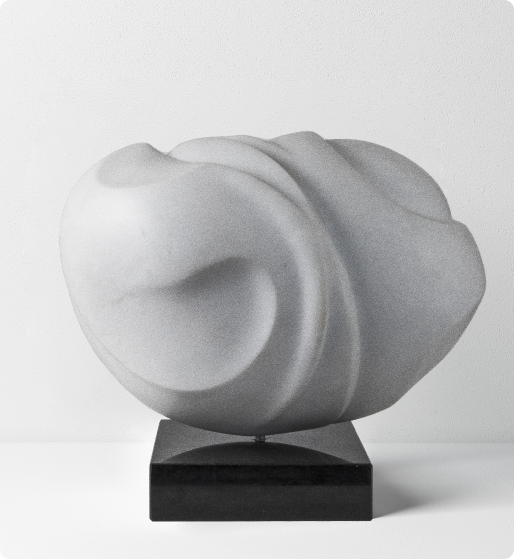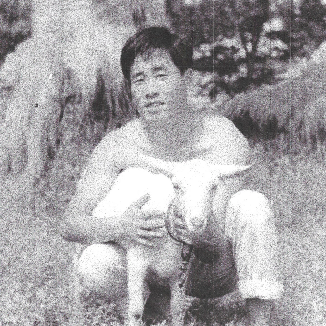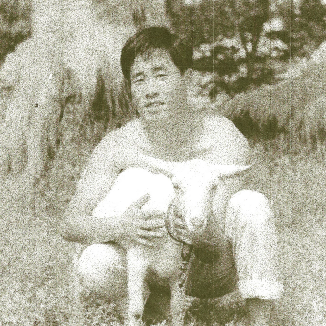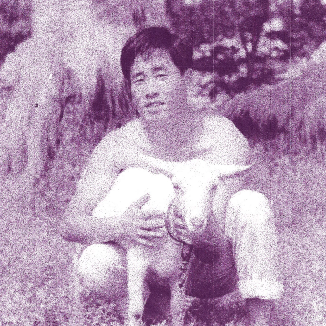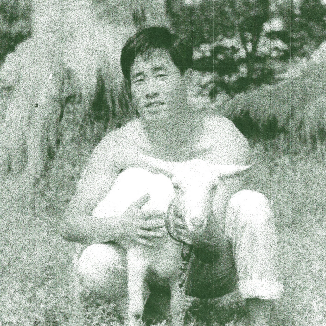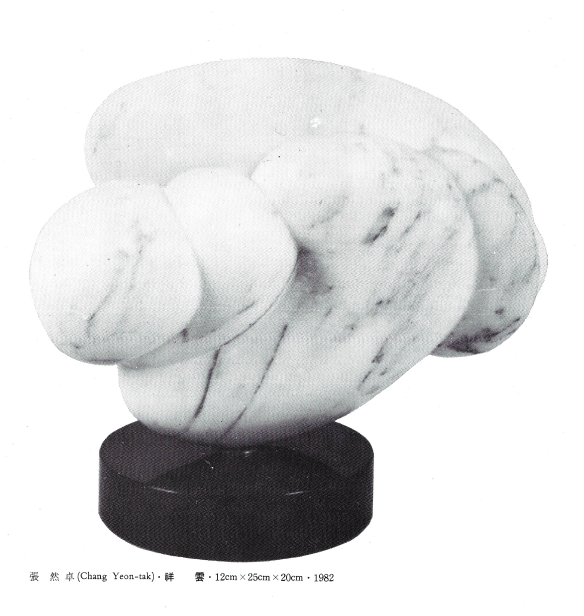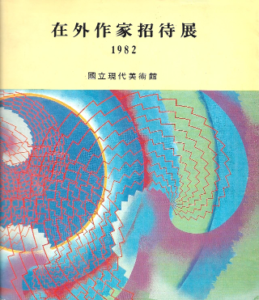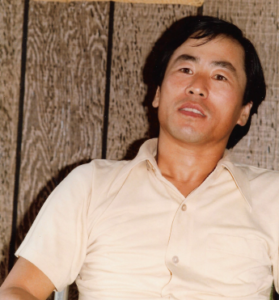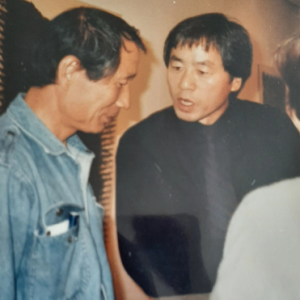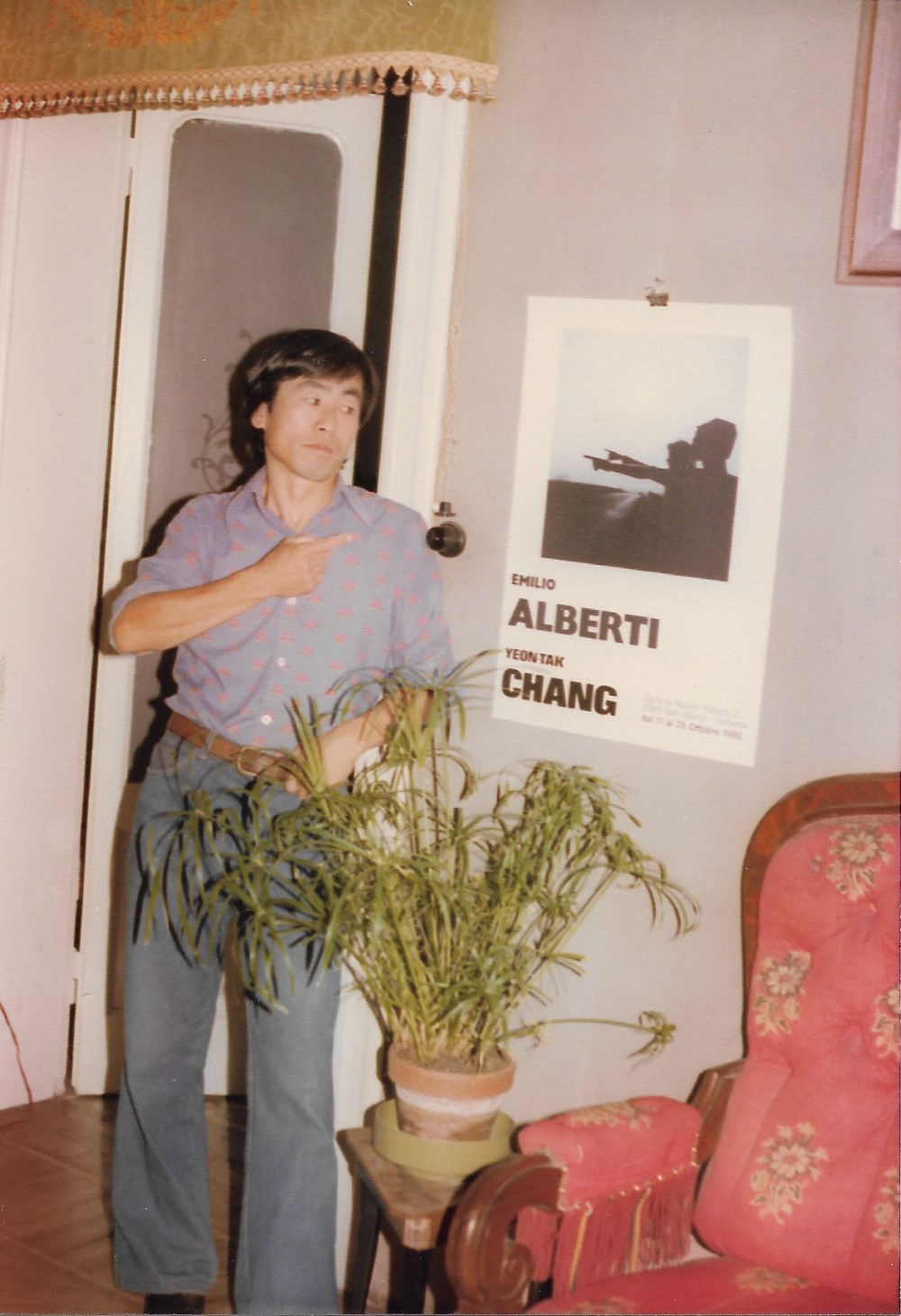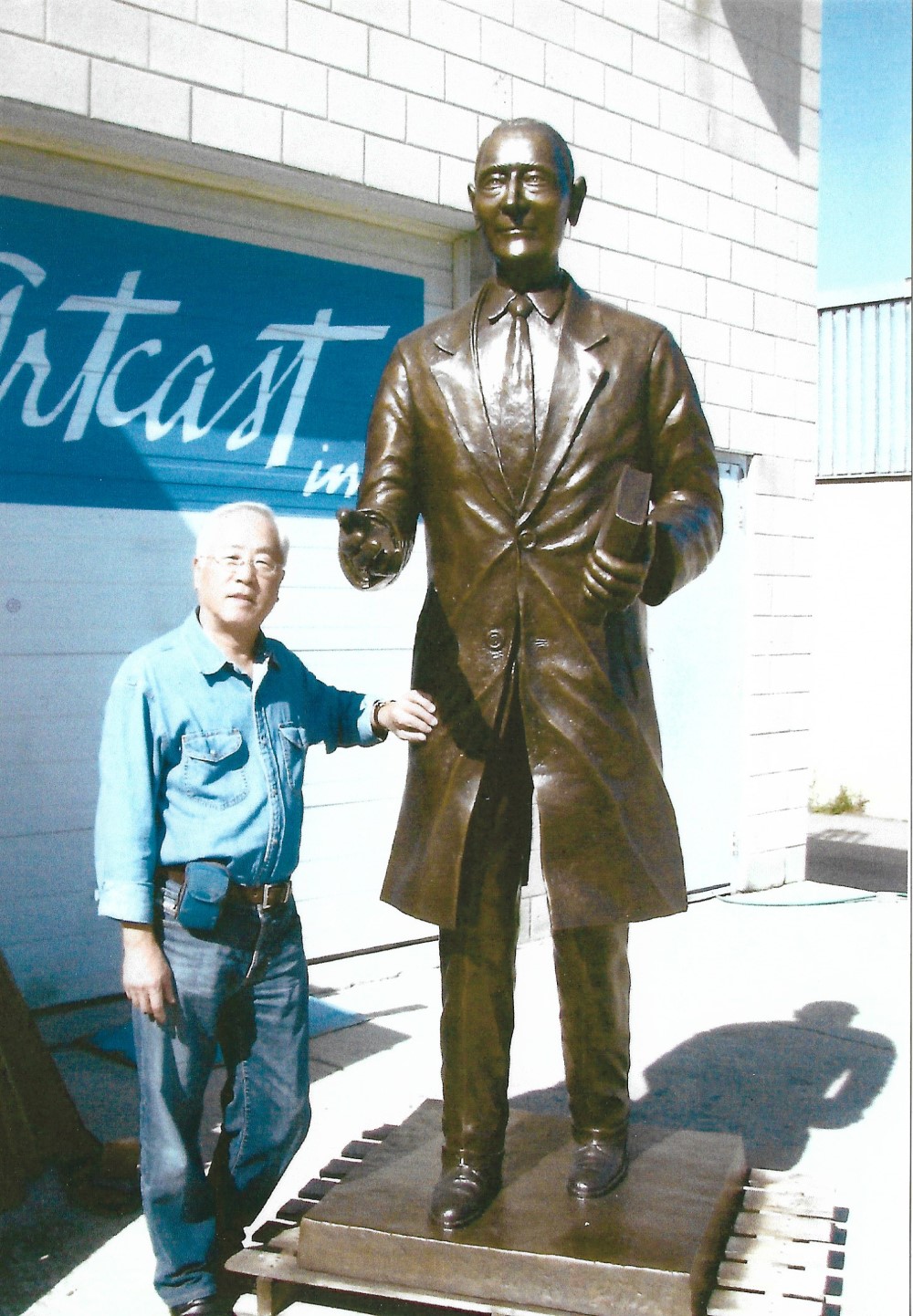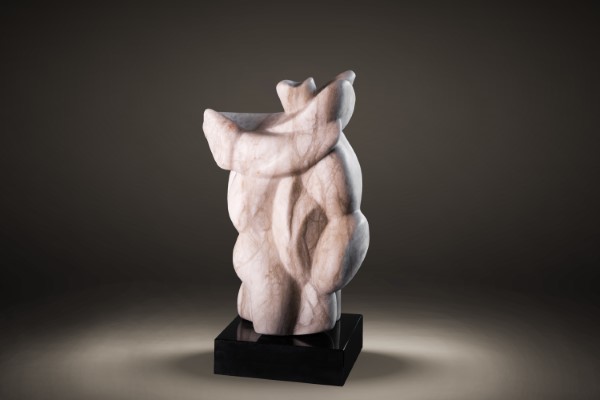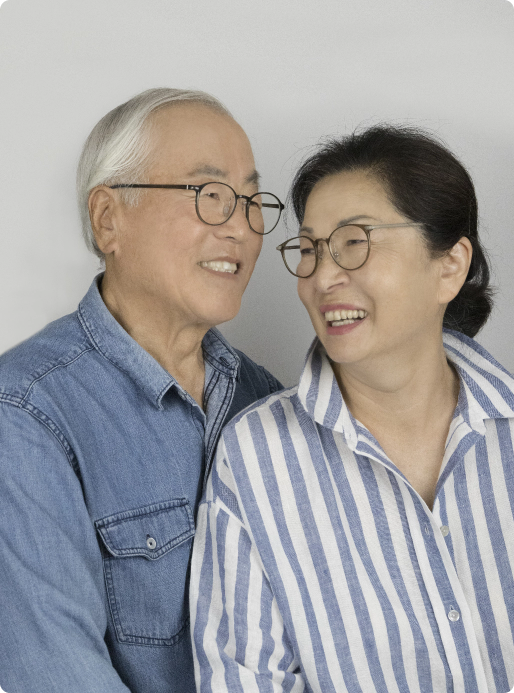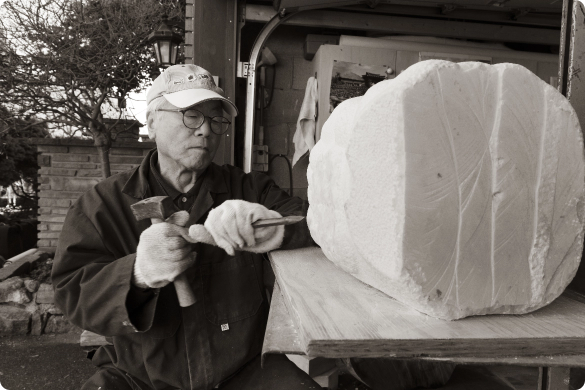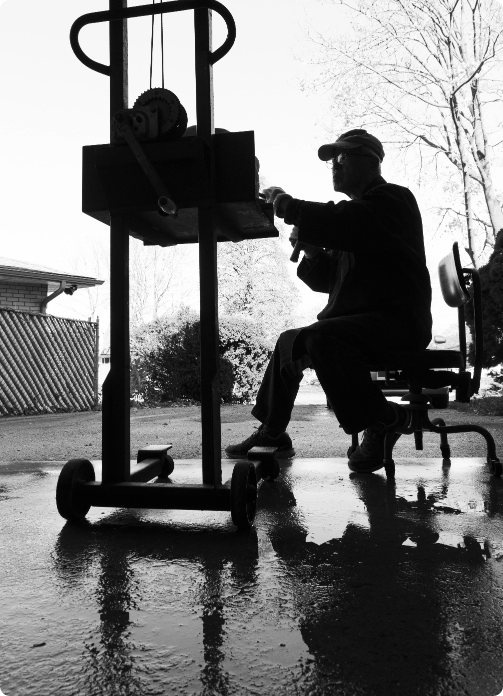By Michael C. Irving, Ph.D.
Chisel rhythmically beating on stone like a poet, like the wind. Like a rock, climbing, struggling with self, challenging sculptor and humanity, reaching up to be free. Yeon-Tak Chang’s sculptural images are simple and powerful. The forms are innovative and simultaneously connected to age-old artforms and philosophy. The sculpture is inseparable from poetry. His images carved into the permanence of stone are filled with life bursting out with meaning.
Yeon-Tak is a powerful, yet quiet and unassuming person. He is solid like the material he carves in. His art images transcend culture and time. As an artist, Yeon-Tak’s life has been deeply connected to aquarian times when people were a part of the vitality of nature. As silent echoes, the poetry in these stones are the sound of water, the sight of wind, the texture of clouds, the smell of the branch falling. Yeon-Tak’s sculptures are a synthesis of east and west and of ancient and modern.
Each simple and graceful sculpture is slowly hewn from raw rock. The exquisite forms come into being through physically demanding labour, combined with keen intellectual pursuit and an ever-present quest for spiritual depth. Yeon-Tak considers, “There may be joy in reaching the top of a pinnacle, but it is the journey which is more important. The struggle and challenge is a spiritual experience. Sculpting purifies the mind. The sculptor’s carving is healing through the stone.”
Yeon-Tak is a mature artist who understands much of himself and his material. His words emanate from the inner voice of an oriental child, steeped in ancient learnings. When you see the modern innovative marble forms before you, also see a Korean farm boy deeply attached to earth, nature, the simplicity of life reaching upward from the soil. See the child on his grandfather’s simple farm in Korea, few toys – mostly hand made. See a child whose shoes were woven from the very rice reeds which also furnished food. See a young child who repeatedly hears the distant train whistle, but does not first hand view that iron oddity which he sometimes sees in a book.
To imagine trains he flew home-made kites. The young artist’s mind refining the poetry of art, travelled the course of the string, up to the kite, into the clouds. Flying in the winds, this child, who was grounded in the soil, envisioned lands and images beyond the valley of quiet farms. These sojourns refined the natural artistic talents of mind and spirit so that now out of each carved stone, life bursts, like the thunder and wind from clouds. Through art he chose to retain a hold on his heritage. Yeon-Tak proudly assures, “The son of a farmer knows plants; knows how to cultivate. This is a connection to nature.” Yeon-Tak’s sculptures own the vitality of life sprouting from soil, water and air. His sculptures can be titled after kites, waves, soaring, seeds, the earth-echoes.
Yeon-Tak reflects, “Stone, earth, tree, are like my body. Nature is myself. I Iive in the city, but nature is like my body. My thoughts are out in the country. The city is empty for me. The country is pure – earth.” Inspiration for his art is replenished through sojourns into nature where the soul can feel close to earth. Yeon-Tak finds a vitality in the sight or sound of running water; a stretch of beach. With the earth in his heart he returns to the stone carving bench to allow expression of his musings. With tools and spirit the sculptor in Yeon-Tak rhythmically gives life to the material – a silent echo. Yeon-Tak says, “Stone carving is very hard physical work, but there is freedom. The sculpture serves as a testing to the artist. Sculpting means being a free man –freedom.”
A raw rock becomes a polished sculpture after much time. For Yeon-Tak the result is not as important as the process. In the studio a small maquette may sometimes be created for a work. More often the stone is directly engaged with hammer and chisel. Yeon-Tak can make very realistic sculpture, but he likes free form sculpture. It is more symbolic poetry for him. “Simplicity of the point is most important.” He perceives his sculpture is like a poem, not like a novel. In the work there is an evolution of building up and cutting back, searching for the basic form. As with the simplicity of the poem all that is unnecessary is taken off. “Branches and tributaries are removed to see the essence of the trunk or river. The most simple poem of the sculpture is its basic form.”
The vitality of the human spirit is brought to bear in each piece as it is repeatedly engaged in a search for form and meaning. “Sculpting is touching nature,” Yeon-Tak experiences, “That kind of process is like prayer – the repeated pounding is like a mantra or chanting. It makes the emptiness inside into meaning.” Yeon-Tak considers, “My Eastern thinking finds beauty in the harmony of art. Art means beauty; beauty is art. Without harmony you cannot make good art. Harmony is love.”
The aesthetic, philosophical and spiritual representations manifested in Yeon-Tak’s images are universal. He says very little about each sculpture and may call a piece Abstract or Study. He states, “I like untitled pieces, when I give a title to a piece people think in that precise vein. I would rather people consider their own reflections.” The sculpture serves as an individual silent echo for artist and viewer, though Yeon-Tak acknowledges, “Sometimes some people cannot catch the echo. They cannot touch or reach out.” Just as the artist must physically and spiritually encounter the raw stone to find meaning and healing, in order to reach the waves of the inner sky, the art viewer must also struggle to quiet the stresses placed on the modern mind and soul.
We all crave the simplicity of nature and earth which Yeon-Tak touches upon in his confrontation with stone. His work is his story and it is our story. As Yeon-Tak muses:
The stone silently echoes the silence between two people. People think silence. The meaning of silence is the silence. When there is no wind and everything is still, there is silence. When you don’t talk there is silence. But the thinking is an echo. The life that the sculptor gives to the silent stone is an echo of the sculptor’s life. My sculpture is silent, but it echoes my mind.
There is no silence in the world, there is always something inside or outside which is moving – that is echo. Silence is not silence, there is always communication – that is echo. There is love – that is echo. You have to open your heart to make the inside out. That makes a sound echo which is communication.
The art exhibition Silent Echo is a passage along a journey. In this show we are given the gift of Yeon-Tak’s echoes and are called upon by him to explore our own echoes. He asks that our paths be individual, but go side-by-side for a while. Yeon-Tak reflects, “I am still travelling. Like a voyager there is a goal, but it is not clear. The journey right now is most important.”
Toronto, March 1996′
This article is reproduced from the 1996 publication “Silent Echo”
featuring works by Yeon-Tak Chang.
